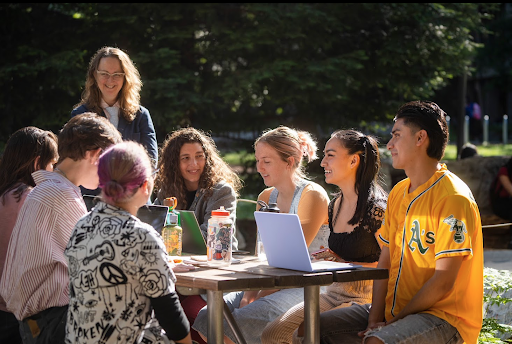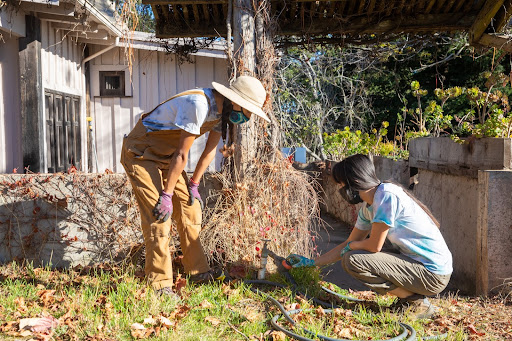UC Santa Cruz anticipates welcoming approximately 5,100 new Banana Slugs this fall, concluding an admissions cycle that reflected increased interest in the campus.
Campus leaders are carefully managing student enrollment and working to provide more on-campus housing for students because of a statewide housing crisis that is particularly difficult in Santa Cruz. The incoming student cohort, which by design is 700 fewer from fall 2021, represents a vibrant mix of first-year and transfer students who will enhance the campus community through their varied experiences and perspectives.
Selected from more than 66,000 applicants, the class of first-year students is academically distinguished and economically and racially diverse, with a mean weighted high school GPA of 3.97. Approximately 36 percent will be the first in their family to attend a university and 40 percent are eligible to receive Pell grants, which indicates they are from low-income households.
“These incoming students — both transfers and those who will be entering their first year at the college level — have shown themselves to be well-prepared, determined and resilient scholars,” Chancellor Cynthia Larive said. “We are so excited to welcome them to our campus community to continue their academic journey.”
UC Santa Cruz’s newest cohort joins a university on an unprecedented trajectory, with faculty pursuing research that is having a transformative impact on society. Reflecting the quality of the campus’ research as well as graduate and undergraduate teaching, UCSC is a member of the Association of American Universities (AAU) and the Association of Pacific Rim Universities (APRU).
UC Santa Cruz shares the distinction of being the youngest member of the esteemed AAU, and is one of only six members that is also a Hispanic-serving institution. Reflecting national leadership in educational equity, UC Santa Cruz joined 21 other top universities in forming the Alliance of Hispanic Serving Research Universities. The campus also is an Asian American Native American Pacific Islander-Serving Institution. For the third year in a row, UC Santa Cruz was ranked among the top twenty universities nationally for student social mobility.
Undergraduate students at UC Santa Cruz experience a small liberal arts college environment with the depth and rigor of a major research university through the pairing of high-impact research with 10 tight-knit residential colleges – a rare combination among U.S. public universities.
Earlier this year, UC Santa Cruz was named the No. 2 public university in the nation for students focused on making an impact on the world, according to Princeton Review. This ranking reinforces what students and alumni know: that UC Santa Cruz is a destination for those seeking to have an impact on society and to effect real change.
Advancing opportunity, access
In an ongoing effort to ensure students know about the transformational opportunities available at UC Santa Cruz, the admissions team expanded its outreach efforts in high schools and community colleges. With another year of record applications, the faculty committee carefully assessed how to provide access to a high-quality and affordable UC education to a diverse cohort of highly qualified students.
For fall 2022, UC Santa Cruz extended an offer of admissions to more than 31,000 high school seniors and 7,000 transfer students. Close to 23,000 seniors and 6,500 transfer students were from California.
UC Santa Cruz extended admissions offers to 989 African American high school seniors from California and 6,878 Chicanx/Latinx California high school seniors. Offers to American Indian first year students increased to 130.
UC Santa Cruz continued regional and statewide outreach efforts to increase interest and applications from transfer students seeking a four-year degree. Having already completed considerable coursework, transfer students have demonstrated their ability to succeed academically, enter UCSC poised for timely graduation, and add valuable perspectives to the campus community. Providing access for California community college students is one of the highest priorities and further diversifies the campus community.
In support of creating a learning environment that exemplifies cultural and geographic diversity, UC Santa Cruz admitted more than 3,200 international first-year students and more than 4,800 first-year students from other states.
The broad diversity from California and other states and countries enhances the community through their varied experiences and perspectives and helps prepare students for successful careers in a global and globally-connected world.
Preparing for fall quarter
Fall instruction begins Sept. 22 with move-in starting Sept. 15. The campus will provide housing for about 9,300 students, more than half of the undergraduate class. An ambitious construction project underway at Kresge College will increase the amount of campus housing available to undergraduate students, and campus leaders are developing a multi-year housing strategy with a project ladder that has projects in the planning, design or construction stage at all times.
Like other University of California campuses, UC Santa Cruz is focused on supporting the health and well being of its campus community. With a widely vaccinated and boosted campus community and a successful COVID-19 testing program, UC Santa Cruz is planning for in-person instruction in the fall.
Incoming students begin their studies during summer, in UC Santa Cruz’s innovative 1-credit online Slug Orientation course. The course is designed to connect new students to academic and social resources, to meet critical campus deadlines, to provide guidance and support for enrolling in first-quarter classes, assist with navigating campus processes, and overall provide a smooth transitional experience.
Hundreds of new students also got an early start to their UC Santa Cruz education through the Office of Summer Sessions’ Summer Edge programs, offered this year in dual formats, for remote students and for students living and learning in Santa Cruz. Programs such as these significantly contribute to UC Santa Cruz’ systemwide leadership in the percentage of first year students who complete their 4-year baccalaureate degree in just three years, most recently 1 in 12 students.
Incoming first year and sophomore students will participate in a robust Welcome Week intended to connect and engage students with each other and the campus. Welcome Week is a continuation of Slug Orientation, and is designed to further introduce new students to vital resources that will support them in their academic and social transition to the university.
Through the required college and major advising presentations, new students will meet staff and faculty from their affiliated college and major. During this week students will have many opportunities to meet other students, learn about student clubs and organizations, and attend workshops that will connect them to work and internship opportunities.




